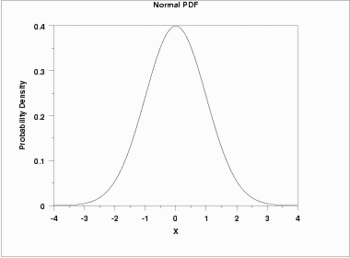Statistical significance: Difference between revisions
imported>Robert Badgett No edit summary |
imported>Robert Badgett (Fixed Goodman references) |
||
| Line 20: | Line 20: | ||
This approach uses mathematical formulas to calculate deductive probabilities (p-value) of an experimental result.<ref name="pmid10383371">{{cite journal |author=Goodman SN |title=Toward evidence-based medical statistics. 1: The P value fallacy |journal=Ann Intern Med |volume=130 |pages=995–1004 |year=1999 |pmid=10383371 |doi=|url=http://www.annals.org/cgi/content/full/130/12/995}}</ref> This approach can generate [[confidence interval]]s. | This approach uses mathematical formulas to calculate deductive probabilities (p-value) of an experimental result.<ref name="pmid10383371">{{cite journal |author=Goodman SN |title=Toward evidence-based medical statistics. 1: The P value fallacy |journal=Ann Intern Med |volume=130 |pages=995–1004 |year=1999 |pmid=10383371 |doi=|url=http://www.annals.org/cgi/content/full/130/12/995}}</ref> This approach can generate [[confidence interval]]s. | ||
A problem with the [[frequentist]] analyses of p-values is that they may overstate "statistical significance".<ref name= | A problem with the [[frequentist]] analyses of p-values is that they may overstate "statistical significance".<ref name="pmid10383371">{{cite journal | author = Goodman SN | title = Toward evidence-based medical statistics. 1: The P value fallacy. | journal = Ann Intern Med | volume = 130 | issue = 12 | pages = 995–1004 | year = 1999 | url=http://www.annals.org/cgi/content/full/130/12/1005 | pmid = 10383371}}</ref><ref name="pmid10383350">{{cite journal | author = Goodman SN | title = Toward evidence-based medical statistics. 2: The Bayes factor. | journal = Ann Intern Med | volume = 130 | issue = 12 | pages = 1005–13 | year = 1999|url=http://www.annals.org/cgi/content/full/130/12/1005 | pmid = 10383350}}</ref> | ||
===Likelihood or Bayesian method=== | ===Likelihood or Bayesian method=== | ||
Revision as of 23:40, 2 August 2009

In statistics, statistical significance is a "term indicating that the results obtained in an analysis of study data are unlikely to have occurred by chance, and the null hypothesis is rejected. When statistically significant, the probability of the observed results, given the null hypothesis, falls below a specified level of probability (most often P < 0.05)."[2] The P-value, which is used to represent the likelihood the observed results are due to chance, is defined at "the probability, under the assumption of no effect or no difference (the null hypothesis), of obtaining a result equal to or more extreme than what was actually observed."[3]
Hypothesis testing
Usually, the null hypothesis is the there is no difference between two samples in regard to the factor being studied.[4]
Statistical errors
Two errors can occur in assessing the probability that the null hypothesis is true:
Type I error (alpha error)
Type I error, also called alpha error, is the the rejection of a correct null hypothesis. The probability of this is usually expressed by the p-value. Usually the null hypothesis is rejected if the p-value, or the chance of a type I error, is less than 5%. However, this threshold may be adjusted when multiple hypotheses are tested.[5]
Type II error (beta error)
Type II error, also called beta error, is the acceptance of an incorrect null hypothesis. This error may occur when the sample size was insufficient to have power to detect a statistically significant difference.[6][7][8]
Philosophical approaches to error testing
Frequentist method
This approach uses mathematical formulas to calculate deductive probabilities (p-value) of an experimental result.[3] This approach can generate confidence intervals.
A problem with the frequentist analyses of p-values is that they may overstate "statistical significance".[3][9]
Likelihood or Bayesian method
Some argue that the P-value should be interpreted in light of how plausible is the hypothesis based on the totality of prior research and physiologic knowledge.[10][3][9] This approach can generate Bayesian 95% credibility intervals.[11]
References
- ↑ Anonymous (2006). “Normal Distribution”, NIST/SEMATECH e-Handbook of Statistical Methods. Gaithersburg, MD: National Institute of Standards and Technology. Retrieved on 2009-02-10.
- ↑ Anonymous. JAMAevidence Glossary. American Medical Association. Retrieved on 2009-02-10.
- ↑ 3.0 3.1 3.2 3.3 Goodman SN (1999). "Toward evidence-based medical statistics. 1: The P value fallacy". Ann Intern Med 130: 995–1004. PMID 10383371. [e]
Cite error: Invalid
<ref>tag; name "pmid10383371" defined multiple times with different content - ↑ Mosteller, Frederick; Bailar, John Christian (1992). Medical uses of statistics. Boston, Mass: NEJM Books. ISBN 0-910133-36-0. Google Books
- ↑ Hochberg, Yosef (1988-12-01). "A sharper Bonferroni procedure for multiple tests of significance". Biometrika 75 (4): 800-802. DOI:10.1093/biomet/75.4.800. Retrieved on 2008-10-15. Research Blogging.
- ↑ Altman DG, Bland JM (August 1995). "Absence of evidence is not evidence of absence". BMJ (Clinical research ed.) 311 (7003): 485. PMID 7647644. PMC 2550545. [e]
- ↑ Detsky AS, Sackett DL (April 1985). "When was a "negative" clinical trial big enough? How many patients you needed depends on what you found". Archives of internal medicine 145 (4): 709–12. PMID 3985731. [e]
- ↑ Young MJ, Bresnitz EA, Strom BL (August 1983). "Sample size nomograms for interpreting negative clinical studies". Annals of internal medicine 99 (2): 248–51. PMID 6881780. [e]
- ↑ 9.0 9.1 Goodman SN (1999). "Toward evidence-based medical statistics. 2: The Bayes factor.". Ann Intern Med 130 (12): 1005–13. PMID 10383350.
Cite error: Invalid
<ref>tag; name "pmid10383350" defined multiple times with different content - ↑ Browner WS, Newman TB (1987). "Are all significant P values created equal? The analogy between diagnostic tests and clinical research". JAMA 257: 2459–63. PMID 3573245. [e]
- ↑ Gelfand, Alan E.; Sudipto Banerjee; Carlin, Bradley P. (2003). Hierarchical Modeling and Analysis for Spatial Data (Monographs on Statistics and Applied Probability). Boca Raton: Chapman & Hall/CRC. LCC QA278.2 .B36. ISBN 1-58488-410-X.